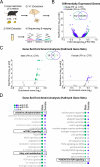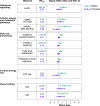Sex-specific resilience of neocortex to food restriction
- PMID: 38976495
- PMCID: PMC11230624
- DOI: 10.7554/eLife.93052
Sex-specific resilience of neocortex to food restriction
Abstract
Mammals have evolved sex-specific adaptations to reduce energy usage in times of food scarcity. These adaptations are well described for peripheral tissue, though much less is known about how the energy-expensive brain adapts to food restriction, and how such adaptations differ across the sexes. Here, we examined how food restriction impacts energy usage and function in the primary visual cortex (V1) of adult male and female mice. Molecular analysis and RNA sequencing in V1 revealed that in males, but not in females, food restriction significantly modulated canonical, energy-regulating pathways, including pathways associated waith AMP-activated protein kinase, peroxisome proliferator-activated receptor alpha, mammalian target of rapamycin, and oxidative phosphorylation. Moreover, we found that in contrast to males, food restriction in females did not significantly affect V1 ATP usage or visual coding precision (assessed by orientation selectivity). Decreased serum leptin is known to be necessary for triggering energy-saving changes in V1 during food restriction. Consistent with this, we found significantly decreased serum leptin in food-restricted males but no significant change in food-restricted females. Collectively, our findings demonstrate that cortical function and energy usage in female mice are more resilient to food restriction than in males. The neocortex, therefore, contributes to sex-specific, energy-saving adaptations in response to food restriction.
Keywords: ATP; female; food restriction; leptin; mouse; neuroscience; sex-specificity; visual cortex.
© 2023, Padamsey et al.
Conflict of interest statement
ZP, DK, PM, MR, EO, NR No competing interests declared
Figures






Update of
- doi: 10.1101/2023.10.06.561185
- doi: 10.7554/eLife.93052.1
- doi: 10.7554/eLife.93052.2
Similar articles
-
Neocortex saves energy by reducing coding precision during food scarcity.Neuron. 2022 Jan 19;110(2):280-296.e10. doi: 10.1016/j.neuron.2021.10.024. Epub 2021 Nov 5. Neuron. 2022. PMID: 34741806 Free PMC article.
-
Sexually dimorphic responses to fat loss after caloric restriction or surgical lipectomy.Am J Physiol Endocrinol Metab. 2007 Jul;293(1):E316-26. doi: 10.1152/ajpendo.00710.2006. Epub 2007 Apr 10. Am J Physiol Endocrinol Metab. 2007. PMID: 17426110
-
Maternal nutrient restriction during late gestation and early postnatal growth in sheep differentially reset the control of energy metabolism in the gastric mucosa.Endocrinology. 2011 Jul;152(7):2816-26. doi: 10.1210/en.2011-0169. Epub 2011 May 10. Endocrinology. 2011. PMID: 21558318 Free PMC article.
-
Physical activity: benefit or weakness in metabolic adaptations in a mouse model of chronic food restriction?Am J Physiol Endocrinol Metab. 2015 Feb 1;308(3):E241-55. doi: 10.1152/ajpendo.00340.2014. Epub 2014 Dec 2. Am J Physiol Endocrinol Metab. 2015. PMID: 25465889
-
Fuel economy in food-deprived skeletal muscle: signaling pathways and regulatory mechanisms.FASEB J. 2007 Nov;21(13):3431-41. doi: 10.1096/fj.07-8527rev. Epub 2007 Jun 26. FASEB J. 2007. PMID: 17595346 Review.
References
-
- Andersson B, Xu XF, Rebuffé-Scrive M, Terning K, Krotkiewski M, Björntorp P. The effects of exercise, training on body composition and metabolism in men and women. International Journal of Obesity. 1991;15:75–81. - PubMed
MeSH terms
Substances
Associated data
- Actions
Grants and funding
- BB/T007907/1/BB_/Biotechnology and Biological Sciences Research Council/United Kingdom
- Danai Katsanevaki/Simons Initiative for the Developing Brain
- 866386/ERC_/European Research Council/International
- 10.35802/102857/WT_/Wellcome Trust/United Kingdom
- ISSF3 N. Rochefort/Wellcome Trust-University of Edinburgh Institutional Strategic Support Fund
LinkOut - more resources
Full Text Sources
Molecular Biology Databases

